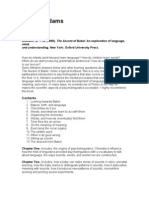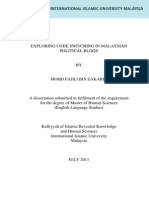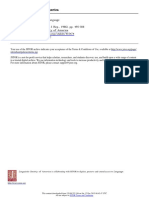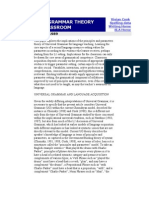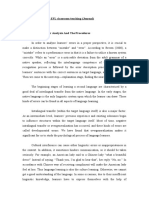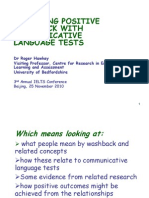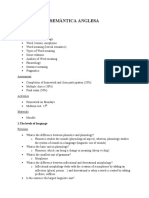Chapter Two Second Language Learning
Uploaded by
Milagros ConcinaChapter Two Second Language Learning
Uploaded by
Milagros ConcinaProfesorado de Inglés
Psycholinguistics
Chapter Two Second Language Learning - Reading Guide and
Activities
Your own ideas
What is “learner language”? Does the term apply to L1 or L2 acquisition, or both? What
characteristics does it have?
Can teachers profit from analyzing learner language? How?
In your opinion, is error-free production a sign of progress and acquisition?
Pit Corder (1967) said that “when learners produce ‘correct’ sentences, they may simply be
repeating something they have already heard; when they produce sentences that differ
from the target language, we assume that these sentences reflect the learners’ current
understanding of the rules and patterns of that language”. How is this assertion connected
to the previous question?
Read
A. Read the section on Contrastive Analysis, Error Analysis, and Interlanguage (p. 41) and
answer the following questions:
What is the Contrastive Analysis Hypothesis (CAH) explanation for learners’ errors?
Find arguments against their position in the rest of the section.
What is Error Analysis? What is the main difference between Error Analysis and
CAH?
Make sure you understand what INTERLANGUAGE, SIMPLIFICATION,
OVERGENERALIZATION, TRANSFER, INTERFERENCE and FOSSILIZATION mean and
how they are related.
B. Study Krashen’s summary of the L2 developmental sequence for grammatical morphemes
on p. 46-47.
Does this sequence apply to speakers with different L1?
If a speaker can produce regular past –ed, for example, can it be assumed that
they can use articles correctly?
What factors seem to influence the order of acquisition?
C. Read about L1 influence (p 57):
List the instances in which L1 seems to have an effect on L2 acquisition.
Profesorado de Inglés
Psycholinguistics
Choose
A. Developmental sequences:
On pp. 45-57 the authors present different developmental sequences (negation,
questions, possessive determiners, relative clauses, reference to past); which of these
features do you think you have had some difficulties in acquiring?
Study the sequence for the feature in question and get ready to describe it to the class and
explain where your difficulties lie.
B. Other components of communicative competence:
On pp. 60-71 the authors discuss the acquisition of areas such as vocabulary, pragmatics
and phonology. Choose the area you are most interested in and prepare a short
presentation for your class.
Analyze
A. Study the sample below and answer: what types of errors can you find? What information
can a teacher derive from analyzing these samples? What errors can be addressed through
teaching, in your opinion?
You might also like
- Test Bank For Communication Sciences and Disorders A Clinical Evidence 3rd EditionNo ratings yetTest Bank For Communication Sciences and Disorders A Clinical Evidence 3rd Edition10 pages
- LIDDICOAT - Five Principles of Intercultural Language Learning100% (1)LIDDICOAT - Five Principles of Intercultural Language Learning2 pages
- A Comparison of Textbook and Authentic InteractionsNo ratings yetA Comparison of Textbook and Authentic Interactions6 pages
- Applied Linguistics: A Genre Analysis Of: Research Articles Results and Discussion Sections in Journals Published in Applied LinguisticsFrom EverandApplied Linguistics: A Genre Analysis Of: Research Articles Results and Discussion Sections in Journals Published in Applied LinguisticsNo ratings yet
- Analysis of a Medical Research Corpus: A Prelude for Learners, Teachers, Readers and BeyondFrom EverandAnalysis of a Medical Research Corpus: A Prelude for Learners, Teachers, Readers and BeyondNo ratings yet
- English as a Foreign or Second Language: Selected Topics in the Areas of Language Learning, Teaching, and TestingFrom EverandEnglish as a Foreign or Second Language: Selected Topics in the Areas of Language Learning, Teaching, and TestingNo ratings yet
- Applied Linguistics LANE 423-DA-Updated PDFNo ratings yetApplied Linguistics LANE 423-DA-Updated PDF6 pages
- Chapter 6 Second Language Learning in The ClassroomNo ratings yetChapter 6 Second Language Learning in The Classroom20 pages
- Communicative Syllabus Design and Testing: Dr. Ambreen Shahriar Dr. Ayesha Sohail Dr. Habibullah PathanNo ratings yetCommunicative Syllabus Design and Testing: Dr. Ambreen Shahriar Dr. Ayesha Sohail Dr. Habibullah Pathan26 pages
- L2 - Discourse Analysis Origin N Development100% (1)L2 - Discourse Analysis Origin N Development19 pages
- The Role of Pragmatics in Second Language Teaching PDFNo ratings yetThe Role of Pragmatics in Second Language Teaching PDF63 pages
- Learner Language in Korean Classrooms: Implications For Teaching50% (2)Learner Language in Korean Classrooms: Implications For Teaching34 pages
- Language Attrition: The Nkpor Igbo Dialect SituationNo ratings yetLanguage Attrition: The Nkpor Igbo Dialect Situation23 pages
- The Effect of PQRST Method On The StudentNo ratings yetThe Effect of PQRST Method On The Student30 pages
- Differences Between First Language Acquisition and Second Language LearningNo ratings yetDifferences Between First Language Acquisition and Second Language Learning2 pages
- Contrastive Studies-History and Development100% (1)Contrastive Studies-History and Development17 pages
- Linguistics For L2 Teachers-Routledge (2000)No ratings yetLinguistics For L2 Teachers-Routledge (2000)165 pages
- Universal Grammar Theory and The Classroom100% (1)Universal Grammar Theory and The Classroom16 pages
- A Content Analysis of The Presentation of The Jordanian National Identity Aspects in The Pupils Book of Action Pack Series 1 6No ratings yetA Content Analysis of The Presentation of The Jordanian National Identity Aspects in The Pupils Book of Action Pack Series 1 613 pages
- Interlanguage Pragmatics and Second Language Acquisition Gabriele Kasper - University of Hawai ... (PDFDrive)No ratings yetInterlanguage Pragmatics and Second Language Acquisition Gabriele Kasper - University of Hawai ... (PDFDrive)15 pages
- Om Teaching (Journal) : Error Analysis and The EFL ClassroNo ratings yetOm Teaching (Journal) : Error Analysis and The EFL Classro14 pages
- Factors Influencing The Speaking Skills of Bachelor of Secondary Education Major in Mathematics StudentsNo ratings yetFactors Influencing The Speaking Skills of Bachelor of Secondary Education Major in Mathematics Students13 pages
- The Functional Approach To Second Langua PDFNo ratings yetThe Functional Approach To Second Langua PDF14 pages
- Noticing Hypothesis in Second Language Acquisition: Nguyen Thi Phuong Nhung, M.A100% (1)Noticing Hypothesis in Second Language Acquisition: Nguyen Thi Phuong Nhung, M.A5 pages
- The Motivational Dimension of Language Teaching100% (1)The Motivational Dimension of Language Teaching23 pages
- Interlingual and Intralingual Interference in Omani EFL StudentsNo ratings yetInterlingual and Intralingual Interference in Omani EFL Students18 pages
- Language Curriculum Design and Teacher DevelopmentNo ratings yetLanguage Curriculum Design and Teacher Development5 pages
- Bringing The Outside World Into The Classroom:: Ways of Making Reading Lessons Less of A Tedious TaskNo ratings yetBringing The Outside World Into The Classroom:: Ways of Making Reading Lessons Less of A Tedious Task4 pages
- The Teacher-Student Communication Pattern: A Need To Follow?No ratings yetThe Teacher-Student Communication Pattern: A Need To Follow?7 pages
- Applied Linguistics Assignment Submitted To Assist - Prof. Ali Muhsin (PHD) By: Anmar Ahmed KadhomNo ratings yetApplied Linguistics Assignment Submitted To Assist - Prof. Ali Muhsin (PHD) By: Anmar Ahmed Kadhom6 pages
- Complexity, Accuracy and Fluency in Second Language AcquisitionNo ratings yetComplexity, Accuracy and Fluency in Second Language Acquisition22 pages
- Teachers Resource Book Resource 40 Lesson 4 1No ratings yetTeachers Resource Book Resource 40 Lesson 4 11 page
- Teachers Resource Book Resource 8 Lesson 1 8No ratings yetTeachers Resource Book Resource 8 Lesson 1 81 page
- WAH5 - Functional Language Worksheets - AKNo ratings yetWAH5 - Functional Language Worksheets - AK3 pages
- This Has To Do With Pronunciation of Individual Sounds, Rather Than Connected SpeechNo ratings yetThis Has To Do With Pronunciation of Individual Sounds, Rather Than Connected Speech3 pages
- Study Guide 2 Mass Culture and Popular LiteratureNo ratings yetStudy Guide 2 Mass Culture and Popular Literature2 pages
- EDUCATION IN THE USA (Chapter 7 From American Ways) 1No ratings yetEDUCATION IN THE USA (Chapter 7 From American Ways) 11 page
- Logicalmathematical and Linguistic IntelligentNo ratings yetLogicalmathematical and Linguistic Intelligent7 pages
- IFI Social Studies I: Education in Comparison: Britain United StatesNo ratings yetIFI Social Studies I: Education in Comparison: Britain United States4 pages
- Expository Writing Course Outline Spring 2024No ratings yetExpository Writing Course Outline Spring 20242 pages
- B. PIVOT 4A Lesson Exemplar Format For Grades 1-10: Monday Tuesday Wednesday Thursday Friday0% (1)B. PIVOT 4A Lesson Exemplar Format For Grades 1-10: Monday Tuesday Wednesday Thursday Friday5 pages
- Guidelines - For - Final Test - Grammar 1No ratings yetGuidelines - For - Final Test - Grammar 13 pages
- W3 - Contrast - "Used To" V.S. "Be - Get Used To"No ratings yetW3 - Contrast - "Used To" V.S. "Be - Get Used To"3 pages
- Sign Language in The Classroom: Using Signing TimeNo ratings yetSign Language in The Classroom: Using Signing Time11 pages
- First Quarterly Test in English With TosNo ratings yetFirst Quarterly Test in English With Tos4 pages
- Q2 - M2 - Current and Future Trends in Media and InformationNo ratings yetQ2 - M2 - Current and Future Trends in Media and Information32 pages
- 2024 Grade 7 English Schemes of Work Term 2 1100% (2)2024 Grade 7 English Schemes of Work Term 2 13 pages


